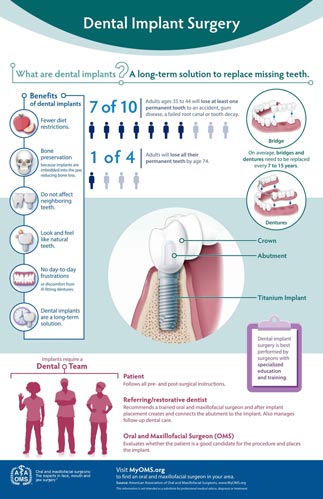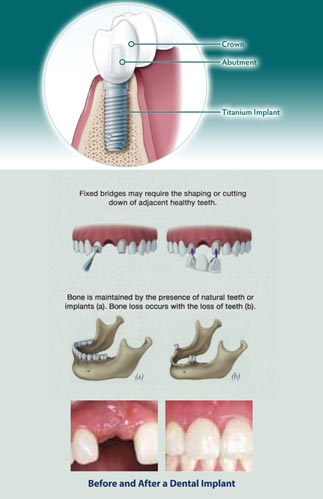Dental Implants
Why Dental Implants?
Dental implant procedures are changing the way people live. The replacement teeth that look, feel, and function like natural teeth, enabling patients to eat virtually anything. Replacing missing teeth with dental implants also preserves and restores facial contours and prevent bone deterioration that occurs when teeth are missing.
The dental implants themselves are tiny titanium posts that are surgically placed into the bone where teeth are missing. These metal anchors act as tooth root substitutes. The bone integrates with the titanium, creating a strong foundation for artificial teeth. Abutments, that look like small posts, then allow artificial teeth to be attached to the implant.

What Type of Prosthesis Are Available?
A single prosthesis (crown) is used to replace one missing tooth — each prosthetic tooth attaches to its own implant.
A bridge can replace three or more teeth and may require only two or three implants.
A complete dental prosthesis replaces all the teeth in the upper or lower jaw, and the number of implants varies depending on type of complete prosthesis (removable or fixed) recommended. A removable prosthesis (over denture) attaches to a locator abutment. (Think of a locator abutment as a ball shaped trailer hitch.) A fixed prosthesis is permanent and removable only by the dentist.
Dr. Laggan performs in-office implant surgery in a hospital-style operating suite, thus optimizing the level of sterility. Inpatient hospital implant surgery is for patients who have special medical or anesthetic needs or for those who need extensive bone grafting from the jaw, hip, or tibia.
Dental Implants Can Last a Lifetime
Dental Implants vs. Bridges
Why Dental Implants?
When a person loses several teeth — whether it’s a new situation or something that has happened over the years — chances are you have never become fully accustomed to losing such a vital part of yourself. Dental implants can renew self-confidence and offer peace of mind.
A Swedish scientist and orthopedic surgeon, Dr. Per-Ingvar Branemark, developed this concept for oral rehabilitation more than 35 years ago. With his pioneering research, he opened the door to a lifetime of renewed comfort and self-confidence for millions of individuals facing the frustration and embarrassment of tooth loss.
Why Select Dental Implants Over More Traditional Types of Restorations?
- When bridges are used instead of implants, the healthy structure of the surrounding good teeth can become damaged, reducing the bridge’s function and lifespan.
- Removable partial dentures can cause many maladies, including sore gums, difficulty chewing and speaking, food lodging under the partial, looseness, breakage, and poor fit due to gum shrinking or tooth loss.
- Removing a partial at night is inconvenient.
- The partial can be poorly functional and embarrassing when they slip and fall out.

Am I a Candidate for Implants?
Candidates for implants undergo a thorough mouth exam and review of medical and dental history. If the mouth is not ideal for implants, there are ways to improve the procedure’s outcome, such as bone grafting.
Frequently Asked Questions
What type of anesthesia is used?
Most dental implants and bone grafts are performed in the office with local anesthesia, with or without IV sedation. Most patients elect IV sedation because of the comfort and peace of mind.
Do implants need special care?
Once the implants are in place, they will last a lifetime with proper care, which includes good oral hygiene (brushing and flossing) and regular appointments with your dental specialists. If needed, other healthcare issues are addressed to maximize the success of the procedure and lifespan of the implants.
What steps are involved?
Placing a dental implant requires several steps that usually involve the oral and maxillofacial surgeon and patients’ general dentist. Many of these steps are combined in the same appointment:
- Examination
- Removal of the tooth or teeth
- Bone graft or site preservation when indicated
- Placing the dental implant (the titanium “tooth root”)
- Placing the abutment and crown (the connector and porcelain tooth)
- Office visits, X-rays, and pre- and postsurgical care
Surgical Procedure
For most patients, the placement of dental implants occurs in one surgical procedure.
If patients are having a tooth removed, the implant is placed into the socket during the same procedure. A small healing cap (abutment) is placed over the implant to contour the gum tissue for the tooth restoration. After the implant site is healed, in about in six weeks, patients return to the office for a quick evaluation and clearance to proceed with the restorative phase. Most often, patients do not require shots to numb the area after the initial surgery.
The process for patients with poor quality bone or insufficient volume of bone is a little different. In these cases, the implant heals beneath the surface of the gum for additional protection. After it has bonded to the bone, patients come back so that the small healing cap (abutment) can be placed over the implant to help shape the gum tissue, resulting in a more cosmetic result. The restorative phase then begins.
When front teeth are involved, temporaries are made to maintain an aesthetic appearance. Each patient is evaluated individually for the most appropriate choice.
When the artificial teeth are placed, the implant components are not seen. Most patients experience minimal disruption in their daily life. In most cases, patients can easily return to work the following day. Postoperative discomfort is considered minimal.


